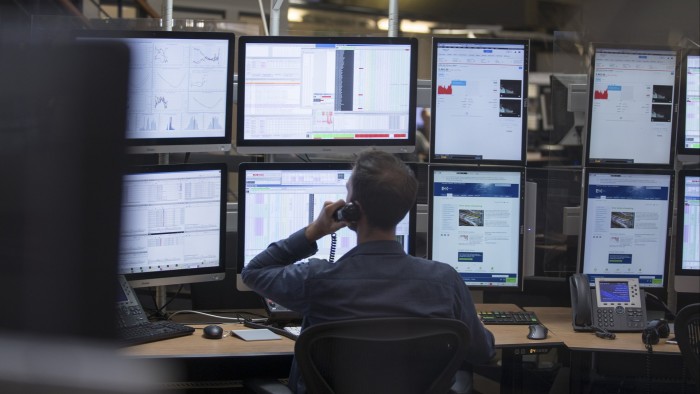Unlock the White House Watch newsletter for free
Your guide to what the 2024 US election means for Washington and the world
A cornerstone of demand in the $1.4tn US junk loan market is under pressure to sell very risky debt, as President Donald Trump’s trade war sparks fears of recession and ratings downgrades.
Collateralised loan obligation vehicles, which own roughly two-thirds of US riskier corporate loans, may need to slash exposure to weaker borrowers most vulnerable to tariffs and recession because of the potential threat of rating downgrades, according to analysts and investors.
The heightened pressure on CLOs is the latest sign of how fears that Trump’s tariffs could sharply slow US growth are rippling through the corporate debt market. Borrowing costs have risen sharply in recent weeks for riskier bonds and loans, while the rate of new issuance has also cooled.
“Whether it’s a recession, a mild recession, a slowdown in growth — at the minimum, we’re going to have a slowdown,” said Roberta Goss, head of Pretium’s bank loan and CLO platform. “That will have implications across the credit markets — and in leveraged finance, that’s going to result in elevated defaults and elevated downgrades over the course of the next year.”
Goldman Sachs lifted its default projections for US loan borrowers sharply last week, anticipating a 12-month trailing default rate of 8 per cent for leveraged loan issuers by the end of this year — up sharply from a previous estimate of 3.5 per cent.
CLOs package up leveraged loans — which are typically extended to borrowers with high debt burdens — into different risk categories, before selling them in slices to investors. The vehicles have held up well during previous periods of economic strain, and issuance was strong at the start of this year, signalling healthy demand for the market.
However, analysts have warned that risk mitigation mechanisms within CLOs could push managers to reduce their holdings of very low-quality loans in the near future — potentially curbing access to funding for the most highly leveraged, weakest borrowers.
“I do think [CLOs] will start selling if it becomes clear that early April’s tariff regime becomes the status quo for a long period,” said James Martin, senior credit strategist at UBS.
While Trump backed down from his “reciprocal” tariff blitz last week, announcing a 90-day hiatus for non-retaliating countries, an escalating trade war with China and erratic policy developments have put economists and investors on notice for a possible growth slowdown.
“Right now, the focus is what the rating agencies will do,” said Pratik Gupta, head of CLO research at Bank of America. While “they haven’t downgraded anything yet, I think those are coming”.
CLOs have limits on how much debt rated triple-C or below — the bottom end of the credit quality spectrum — they can hold, with a typical threshold of 7.5 per cent of all assets for CLOs that hold public-market or “broadly syndicated” loans.
While recent data from BofA showed that the average US CLO held about 6 per cent of its assets in triple-C-rated debt, well below that ceiling, Gupta anticipates that if current tariff announcements hold, an increase in ratings downgrades can push this figure to 7.7 per cent “in the near term”.
A jump above that 7.5 per cent ceiling could flip protective switches within CLOs, leading to risk assessments that might ultimately cut off cash flows to investors in the lowest-quality tranches of the CLO, known as “equity”, in order to redirect payments to investors higher up the capital structure. Such a scenario could, some market participants said, reduce the appeal of CLOs for investors in the riskiest tranches.
For now, strategists said that CLOs had a decent “cushion” and should still be able to absorb several downgrades until they reached the stage of needing to sell loans aggressively. They added that the path ahead for CLO managers would be determined to some extent by the next stages of Trump’s trade war and how far tariffs were ultimately imposed.
Still, against a backdrop of rising recession fears, some market participants said they were already seeing managers beginning to “clean up” their portfolios to avoid being stuck with overflowing triple-C buckets — reducing their holdings of loans that could be particularly vulnerable to downgrade.
Recommended
“Many managers are now proactively trying to front-run by selling risky B-minus names,” said Gupta, referring to loans rated just above triple-C. “Certainly, sales have picked up quite a bit . . . I think you are seeing increased trading activity across the board from the perspective of downgrade risk.”
Pretium’s Goss added that in recent weeks the basket of US corporate borrowers whose debt was trading below 90 cents on the dollar — “representative of future triple-Cs and defaults” — had moved from 6 per cent to more than 10 per cent of the entire loan market, indicating that investors were reducing their holdings of riskier single-B-minus and triple-C-rated names.
“That is exactly why people fear that there could be increased risk around restructurings,” said Gupta, referring to the process whereby distressed companies reconfigure their debt piles, typically to the detriment of existing lenders.



